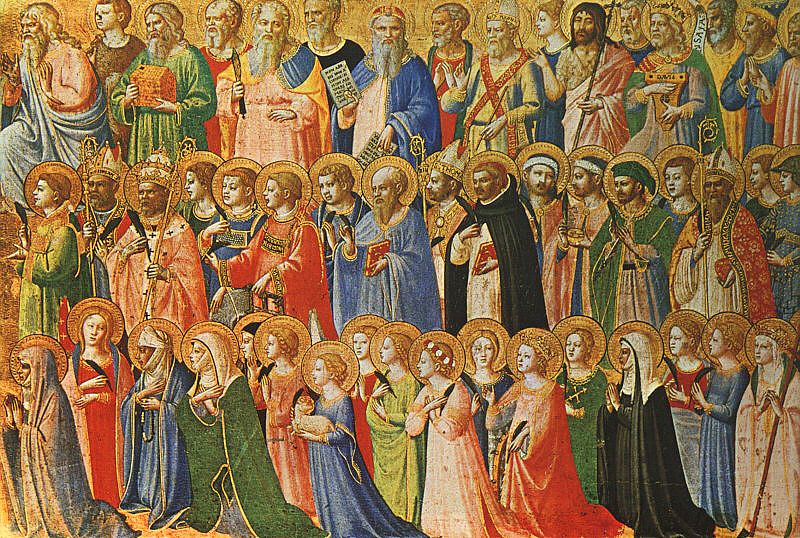All Saints Day at Church of Our Redeemer
The Feast of All Saints
We’ve all heard of St. Peter and St. Patrick, but you’ve probably met a saint in your own life: someone who makes a difference in the lives of other people and shows God’s love. The![]() Feast of All Saints is when we celebrate all the ordinary, everyday saints of our lives, especially our own loved ones who have died. On All Saints we especially remember that each Sunday when we worship, we are surrounded by the “cloud of witnesses” of those who have gone before us in faith and have passed on to God’s eternal rest.
Feast of All Saints is when we celebrate all the ordinary, everyday saints of our lives, especially our own loved ones who have died. On All Saints we especially remember that each Sunday when we worship, we are surrounded by the “cloud of witnesses” of those who have gone before us in faith and have passed on to God’s eternal rest.
You probably know that All Saint’s Day is connected to Halloween, which is “All Hallow’s Eve”; or another day name for the night before All Saint’s Day. Actually, Halloween came first. Halloween has roots in Celtic festival of Samhain. In Ireland and Scotland, day that marked end of summer and beginning of reparations for winter. Longer nights, colder days, dying crops, made it seem like life was giving way to darkness and decay. Samhain observed that even as summer turns to winter, in human lives youth turns to old age and then to death. There was a belief that boundary between living and dead was thin on that night, and the spirits of departed were thought to roam the earth, so offerings of food and drink were left for them. Dressing in costume and going door-to-door asking for food were also part of the festival.
Then along came the Christians.
In 300’s, Christianity spreading across Celtic world. Christians faced with same challenge we face today: how do we communicate good news of Christ using ideas and customs that make sense to people, without watering down the gospel? Pope Gregory the Great, who became pope in 590, specifically instructed Christian missionaries to the British Isles to not condemn the local religion, but adapt and work with it to show how it pointed to Christ.
So, Christians looked at this Celtic festival that recognized the power of death and paid homage to the spirits of the departed and said, hey, that’s just like our saints days. From the time of the Roman persecutions, Christians had set aside certain days to remember a specific saint on the day that they died. But as the number of saints grew with each passing century, there were more than 365. So All Saints Day was first observed in the 7th century to honor all those who didn’t have an individual saints day. However, it wasn’t originally on November first. It didn’t have a fixed day until it was placed on the calendar next to Samhain. In 800 AD Pope Boniface IV declares All Saints Day, the day of the holy or hallowed, on Nov. 1. Christians started calling the day before All Saints Day, All Hallows Eve, and thus Samhain was co-opted and got a new name, Halloween.
However, some of the Celtic practices still hung on, such as “Souling” – the poor of the community would go from house to house to ask for bread or cake in exchange for prayers on behalf of loved ones who had died. The soulers would carry carved out turnips with a candle inside to light their way, signifying the souls of the dead trapped in purgatory, which became today’s Jack o’lanterns. As you might imagine, the Protestant Reformers of the sixteen century hated Halloween just like they hated Christmas. So the spiritual practices of prayers and souling died out, and it became mostly a folk culture holiday with the witches and ghosts we know today.
But what does All Saints mean to us?
In ancient times and now, it reflects how we think about death. It is scary or not? Or both? How do we stay connected with those who have died? All Saints confronts our fear of death with faith in life after death, and our fear of spirits of death with faith that faithful departed surround us with love and prayers, that we are all in communion with each other. It acknowledges power of death, but says that death does not have ultimate power over us. It confronts death with resurrection power of Christ, that we acknowledge by renewing our Baptismal vows on this day.
We want to remember the loved ones you are missing and the everyday saints who are important to you on All Saint’s Day.
On Sunday, November 4th, please feel free to bring a photo or memento of a loved one who has died with you to church on November 6, and place it in the window ledges (or we will help you find a place for it). If you forget, we will have notecards for you to write down the name of your loved one.
This cloud of witnesses surrounding us will be a tangible reminder that our loves ones are still with us in the Community of Saints and God’s love unites us always. Bring a photo of your “saint” with you to church on All Saint’s Sunday.


great website i love it catholic